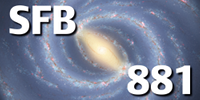Subproject B2: Molecular Clouds in the Milky Way and Their Ability to Form Stars
Ralf Klessen (ITA), Cornelis Dullemond (ITA), Rainer Spurzem (ARI)
Simulations of molecular cloud formation, evolution and destruction, including the assembly of clouds from converging flows of warm atomic hydrogen, the formation of stars within the clouds, and the eventual dispersal of the clouds. Constraints on cloud lifetimes, star formation rates, and the properties of embedded star clusters.
Subproject B2 focused on the formation and evolution of individual molecular clouds rather than on Galactic scales as in B1. In the first funding period, the chemical network was improved to better account for the coupling between matter and the interstellar radiation field. We now have the technical capabilities to describethe formation and evolution of star forming molecular clouds with complementary magnetohydrodynamic simulations codes (FLASH, Gadget, Arepo) coupled to a time-dependent chemical network for the most relevant atomic and molecular species in the ISM (subproject B3, completed) with a realistic link between matter and the ambient radiation field. We can use sink particles to model protostellar collapse and star formation and we have developed modules for the most important feedback processes (supernova explosions,ionizing radiation, winds and protostellar outflows; subproject B4, completed). Moreover, realistic syntheticmaps can now be constructed from the simulated clouds based on detailed radiative transfer calculationswith the RADMC-3D code. In B2, the first 3-D models of converging flows that self-consistently trace the formation of H2 and CO were calculated. Also, it was shown that CO cooling is not needed to form stars; C+ cooling is sufficient.
Publications
Clark, P.C., Glover, S.C.O., Ragan, S.E., Shetty, R., Klessen, R.S.: “On the Temperature Structure of the Galactic Center Cloud G0.253+0.016”. ApJ, 768, 34 (2013)
Clark, P.C., Glover, S.C.O., Klessen, R.S.: “TreeCol: a novel approach to estimating column densities in astrophysical simulations”. MNRAS, 420, 745 (2012a)
Clark, P.C., Glover, S.C.O., Klessen, R.S., Bonnell, I.A.: “How long does it take to form a molecular cloud?”. MNRAS, 424, 2599 (2012b)
Girichidis, P., Federrath, C., Allison, R., Banerjee, R., Klessen, R.S.: “Importance of the Initial Conditions for Star Formation - III: Statistical Properties of Embedded Protostellar Clusters”. MNRAS, 420, 3264 (2012)
Glover, S.C.O., Clark, P.C.: “Is molecular gas necessary for star formation?”. MNRAS, 421, 9 (2012)
Glover, S.C.O., Federrath, C., Mac Low, M.-M., Klessen, R.S.: “Modelling CO formation in the turbulent interstellar medium”. MNRAS, 404, 2 (2010)
Peters, T., Banerjee, R., Klessen, R. S. Mac Low, M.-M.: “The Interplay of Magnetic Fields, Fragmentation and Ionisation Feedback in High-Mass Star Formation”. ApJ, 729, 72 (2011)
Peters, T., Klessen, R.S., Banerjee, R., Mac Low, M.-M.: “Limiting Accretion onto Massive Stars by Fragmentation-Induced Starvation”. ApJ, 725, 134 (2010)
Parmentier, G., Baumgardt, H.: “The mass function and dynamical mass of young star clusters: Why their initial crossing-time matters crucially”. MNRAS, 427, 1940 (2012)


